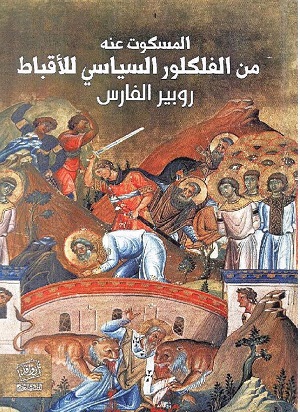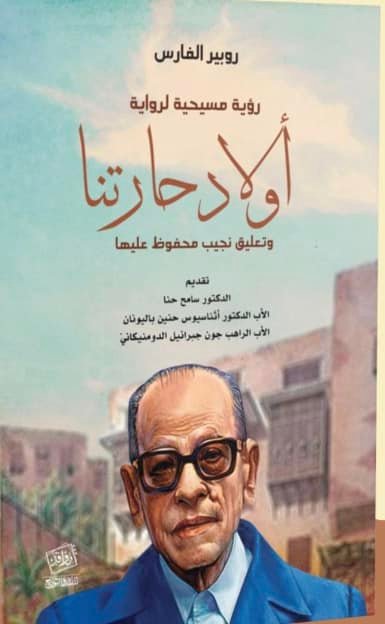In three books produced over the last five years, researcher Robert Fares explains why the Copts of Egypt can never be confined to a ghetto, whether by force or their own volition, but instead form an integral part of Egyptian national identity.
Statements on national unity often sound like plain lip service that is offered at official celebrations or at moments following incidents of sectarian violence. However, the joint heritage that all Egyptians share in their life day-in-and-day-out show that there is a real case for national unity and against religious segregation in Egypt that keeps the national harmony despite sentiments of segregation.
This is the basic argument that researcher Robert Fares offers in his 140-page book Al-Maskout Anoh fi Alfolklore Alseyassi Llaqbat (“The Disregarded Elements of Coptic Political Folklore”).

“The disregarded elements of Coptic political folklore” (Al-Maskout Anoh fi alfolklore alseyassi llaqbat).
The book that Rawefad Publishing put out in 2016 could easily be seen as part of an extended labour that Fares, a leading figure of the Coptic Reformist Movement, has been committed to over a 25-year-long writing career. The purpose of this labour, the same as the Coptic Reformist Movement, is to encourage Copts to never hide behind the walls of their Church and to be more engaging about their faith and their history.
Ultimately, as Fares shows through the pages of this particular title, faith is integral to the Egyptian identity in a way that goes beyond the differences between Christianity and Islam. The idea of faith itself, he argues, is what makes it possible for the followers of both religions in this country to share so much in terms of the traditions – irrespective of the many differences of the two religions, which must be acknowledged.
The accounts of Rabeia Al-Adawiyah, the Sufi Saint, and Mariam Al-Massraiyah, the Coptic Saint, Fares writes, are too similar. The similarity, he suggests, could more easily be attributed to the Egyptian narrative of these two saints than to the similarities of their actual histories.
Moreover, he adds, the mausoleum of Al-Eryan, in Upper Egypt is visited for blessings by both Copts and Muslims as it is believed to be of a saint that is argued to be Copt by some and Muslim by others.
These accounts, Fares argues, are more often than not overlooked in the Coptic discourse. This, he said, should not be the case at all.
The purpose of openly examining these stories, he says, is not at all to contribute to the lip service on national unity, but to assert the shared national identity that is predominantly Egyptian rather than anything else.
The pursuit of the holistic nature of the Egyptian identity, he adds, goes against the call that some are promoting for the segregation of Copts – either by Muslims or by those Copts who believe they need to be strictly confined behind the walls of their Church.
Copts, Fares maintains, have nothing to hide from and nothing to hide. Their subscription to Egyptian identity, he added, is perfectly legitimate.
In 2021 and 2022, Fares published two subsequent books that subscribe to the same argument and which can be safely summarised by the slogan “two religions and a shared identity.” Last year, Rawfed Publishing put out the thoroughly researched and documented 500-page title Al-Magalat Al-Qabettiya (“The Coptic Magazines”). This year, it put out Awlad Haretena – Roweiya Massiheiya (“The Children of the Alley – A Coptic Read”).
What both books do, in parallel takes, is to present the Coptic voice on issues that go way beyond the complaints about discrimination and persecution. This, Fares does by just sharing Coptic voices and Coptic documents.
In The Coptic Magazines, Fares documents over 100 years worth of Coptic magazines in Egypt, stretching back to 1892. In her introduction to the book, political science professor Nevine Mossad said that the way Fares shared the documents and accounts in this title offered an unprecedented insight into the heart of the Coptic Church.

“The Coptic Magazines”, (Al-Magalat Al-Qabettiya)
Fares, Mossad writes, “opens the gates of the Church and talks [honestly and freely] about the relations between the Church and the authorities and the role of the Church in politics”. She argued that the objective of the author was not to glorify the Church in absolute terms but to share the history in a purposeful context that aims to dissect and not to just recall history.
Certainly, in his critique of the long history of Coptic magazines, Fares does not hesitate to say time and again that the Church often enough intervened into the editorial policy and even in the content of these magazines. At times, he writes, the Church banned certain issues of some magazines for having dared to challenge the authority of some of the clergy or the head of the Church. Egypt’s iconic Pope Shenouda III, he wrote, suspended the publication of Magalet Al-Keraza (“The Call for Christianity Magazine”) at times when he could not review or censor its content.
What Fares seems to be keen on doing is to allow the wider public to learn about the history of the Copts of Egypt and to prompt Copts themselves to think thoroughly about some segments and elements of their history with no uncalled-for sense of fear or remorse.
In his 140-page title published this year – Awlad Haretna – Roweiya Massiheiya – Fares takes the lead in examining the most contested literary text of Naguib Mahfouz through a Christian lens. Mahfouz’s book was actually banned for years in Egypt due to criticism by Muslim religious authorities.

“The children of the alley – A Coptic read”, (Awlad Haretena – Rowe’iya Massiheiya”
Fares’ approach to the text reveals how Muslim and Christian religious quarters would share the same objections to Mahfouz’s novel.
Critics from both quarters, he reminds the reader, claimed that Mahfouz was referring to God through Gabalawi, the lead character in the novel. The novel’s title has also been translated as “Children of Gabalawi.” The children of Gabalawi, critics also said, are only the prophets.
Mahfouz explained himself by saying that Gabalawi is about a certain perception that some people choose to have of God.
For Fares, however, whether Gabalawi is about God or an idea of God that some people have, this novel is about the long and onerous search for identity that people have to go through.
These three books offer ample material for readers who wish to learn about a very crucial and often undiscussed issue of the Coptic battle between isolation and engagement. They are addressed to the wider audience and not strictly to a Coptic readership as they tend to be labelled at some bookstores in Cairo.
Short link: